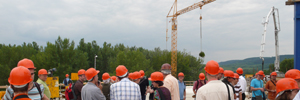
Evaluation of Coupled Numerical and Experimental Partial Models in Structural Engineering (2008 - 2018)
In engineering/construction planning, a wide variety of models exist side by side, which are intended to evaluate the functionality, safety and reliability of structures. In general, a single comprehensive model is rather very complex and thus, global problems must be dealt using partial models. There are innumerable, often complex, partial models that are largely developed and used independently from one another and, in some cases, are coupled together to describe global problems.
The assumptions and simplifications made during modelling leads to results that can only be interpreted as an idealized depiction of reality. The way in which the partial models are coupled to form an overall global model plays an essential role which is being neglected so far by the current state of art. Overall, there are no fundamental studies to date to evaluate the quality of (partial) models taking into account the influences from model coupling. Confidence in the prediction of a particular engineering model has so far been largely based on the experience of engineers.
The outlined problem and thus the topic of the GRK 1462 were dealt with in two phases. The first phase concentrated on the development of a methodical basis for evaluating the quality of prognosis models for structural engineering in a quantifiable manner. The systematization of model properties, synthesis and analysis methods as well as the interaction of partial and global models was important. Essential model properties were sensitivity, robustness, complexity and areas of uncertainty. Adaptive, stochastic, inverse and multi-scale modelling were worked out as future-proof working methods. Evaluable algorithms were used to verify the calibration and validation of developed models and methods for quality assessment and comparability for the tested coupled models. At the same time, reference objects were processed over the entire project period – in addition to the exemplary testing for gaining knowledge.
The second phase was dedicated in particular to the quantitative evaluation of partial models and their coupling under the holistic consideration of blurring effects. In addition, investigations were carried out on the interaction of experimental models with the mathematical and numerical models. The focus was on the description of different experimental models, starting with experiments on small parts up to the monitoring of complex structures. The creation of a consistent methodology for evaluating hybrid, i.e. coupled numerical and experimental forecast models in structural engineering and, in particular, their interaction, provided interesting insights into evaluating the quality of models. It turns out that the quality of the recording (measurement, transmission, recording and long-term storage), systematisation and evaluation of measurement data play an essential role in the process of model evaluation. A realistic assessment of the informative value and quality of global models based on the coupling of partial models is therefore only possible through the use of hybrid models.
The definition of quality requires subjective target definitions even with objective boundary conditions and system limitations. Therefore, the introduction of a generalized method for evaluating engineering models is only possible to a limited extent. Quality can only be understood as an evaluative quantity that can be objectively represented. Under this postulate, in most cases, extensive scientific investigations, especially on the model coupling and the partial models, were necessary in order to establish standardized reliability criteria or rules.
The quality of the global models will undergo a considerable change in the coming years with enhanced possibilities in modelling more complex systems, components and building structures. In this context, the evaluation of partial models interaction is increasingly important.
Dedication
The researchers involved in the 1462 Graduate School would like to take this opportunity to thank the German Research Foundation in particular for the funding they have given and for the very professional and helpful support they have given to the program.
Special thanks go to our esteemed colleague Professor Tom Schanz. His intensive commitment during the project application phase and in the management as a spokesperson, as well as his technical and ideal support, were of extraordinary importance for the success of this project. It is therefore very important for us to dedicate this report and thus the result of the Research Training Group to him.


